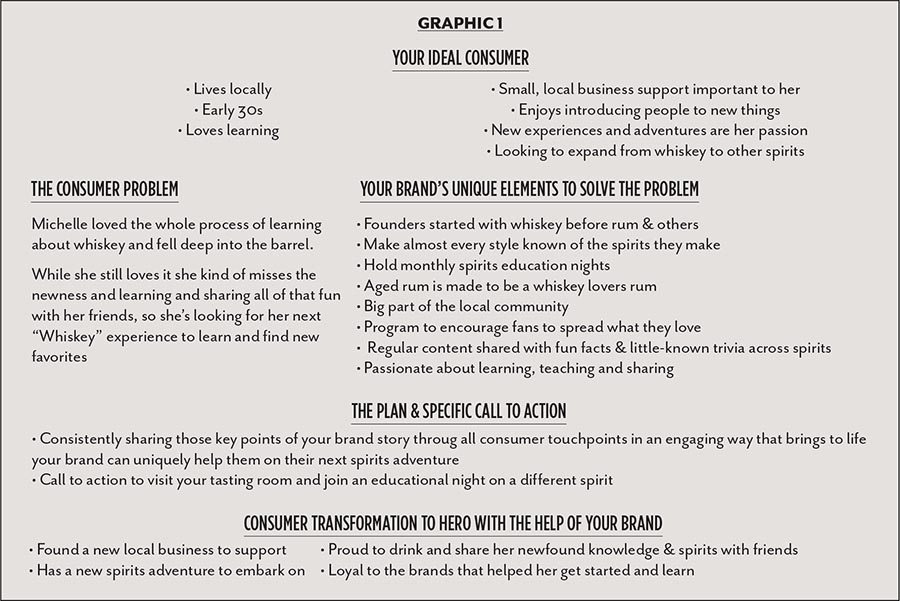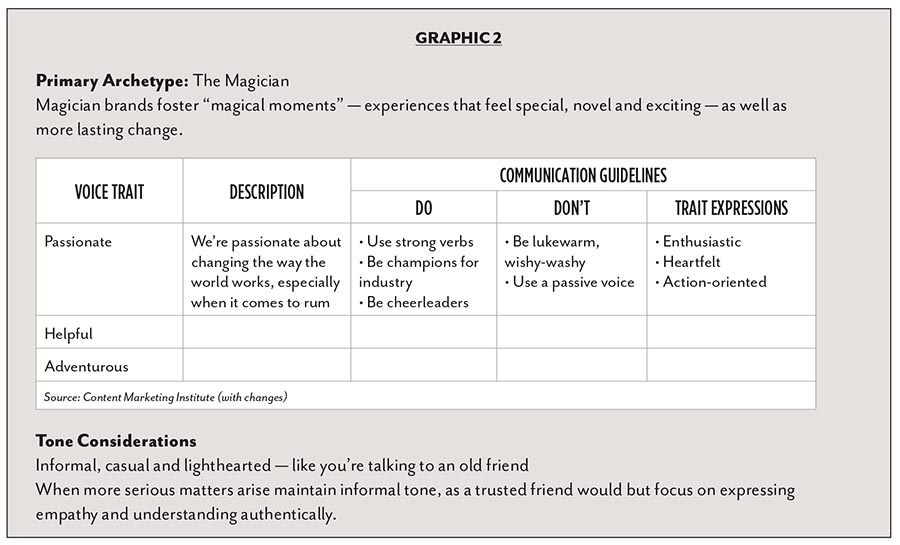When craft distillers first start thinking about marketing, they often focus in on branding, logos, social media, websites and other tactical marketing elements. By jumping in tactically, however, you’re missing the most important part of successful marketing. You. Who you are. Why you do what you do. How you’re different and what you stand for. Without those elements your marketing will be shallow, lack meaning and remain tactical instead of being the strategic engine it should be for your distillery. So how do we fix that? We develop your brand story and brand voice. And then we infuse them into every future marketing decision and tactic.
What Is a Brand Story?
A brand story is a narrative that elicits an emotional connection or reaction by conveying both the tangible and intangible elements of your brand. To be clear, this isn’t necessarily a story that you’re writing out to share with the world. Nor is it your founder’s story. It is a story that helps you understand and identify your brand’s key elements as what should be consistently messaged throughout all of your marketing efforts to best attract your ideal consumers.
The common elements of a good brand story include:
- Your consumer as the character destined to be the hero of the story.
- A consumer-relevant and meaningful problem/need/want/desire/opportunity.
- Your brand as the guide within their story.
- A plan, leveraging the unique elements of your brand, that can help the consumer solve their problem.
- A transformation of the consumer into the hero as he/she understands your plan and follows your call to action.
Without a good grasp of your brand story, you’re jumping in at #4 with your marketing efforts. Not surprisingly, if you start at #4 without understanding the first three components, you’re not as likely to even get your consumers’ attention. And you’re much less likely to help your consumers get the transformation they’re seeking, which is what drives real connection and loyalty. Why? Because you don’t understand them and you don’t understand what you uniquely have to offer them yourself. And that means a lot of wasted marketing efforts. (See Graphic 1).

What Is a Brand Voice?
A brand voice is the personality of a brand infused into any and all communication touchpoints. Or rather, how you convey your brand personality to the world consistently. This includes things like your brand traits, archetype and tones. How do you reinforce the marketing messages you put out in the world with intangible and subtle reinforcement of your brand? If your logo or brand name weren’t on a piece of content, would the consumer still know it’s from you? That’s the power of a strong brand voice. Even when you’re not selling or pitching or pushing your brand and product, they still recognize it’s you, appreciate the value of what you’re sharing and continue to deepen their relationship with you because of that.
A good brand voice includes an understanding of your primary brand archetype, or a universally familiar character that you assign to your brand, as well as your top three brand traits, communication guidelines and tone considerations.
(See Graphic 2).

Without these elements, it’s incredibly hard to ensure that every piece of marketing content you put out there sounds like it’s coming from your brand. This problem is exacerbated if you have more than one person or agency creating content, since everyone naturally defaults to their own personal voice or interpretation of the brand voice in the absence of clear guidance.
Why Do I Need These Exactly?
In a world where consumers are surrounded by brand messages — in stores, while out drinking, on Facebook, Instagram, Twitter, in articles, on websites, at community events — your brand story ensures they are subtly yet consistently hearing the same key messages from you. This helps them create a deeper connection to your brand while moving them down the consumer journey to purchase/visit and, hopefully, become loyal. Similarly, your brand voice ensures that regardless of the content or location of the message, they know it’s coming from you. Why is that important? So you get credit for it! Consumers see so many marketing messages from so many brands similar to yours every day. You don’t ever want them to remember your content but not remember it’s from you, or worse, think it may have been from one of your competitors! Your story helps you stand out to them amidst all the clutter, and your voice ensures they know it’s you that’s standing out.
Marketing is a long game, like developing a relationship. Without understanding and activating your brand story and voice, it’s like your marketing is trying to skip you from stranger to husband overnight. That simply isn’t how marketing works with today’s consumers. You have to take the time to develop a relationship, court the consumer, maybe take them on a quick vacation and then ask them to “marry you.” Or rather, choose to spend their hard-earned dollars with you instead of that other cute spirit across the way.
How to Develop My Brand Story & Voice?
To develop your brand story and brand voice, you really have to sit yourself down, ask some tough questions and dig deep. One of the reasons this critical, up-front marketing work is so often passed over is because it’s deep-thinking work rather than deep-doing work. As craft makers and entrepreneurs, you’re busy. So doing the things that allow you to check the most tangible items off your list the fastest often get priority, even if they aren’t as high in long-term, strategic value. Things like hire a web designer, pick a brand name, open up social media accounts, start posting on social media: check, check, check, check. But the value of all of those items are greatly diminished without the foundation of a brand story or brand voice. Here are my top three tips to get started on developing your own brand story and voice:
Know Yourself Deeply — Watch the TedTalk “Start with Why.” Then sit down with some friends and ask them to drill you with questions about why you started your business, who your ideal consumers are, why you’re making what you’re making and more. Record it or take notes and then start to find themes, ahas or oh nos. Keep drilling deeper. You’re looking for your reason for being, personal elements of your background, values, unique differentiators and marks you’d like to leave behind.
Identify Your Brand Archetype — Take a few online brand archetype quizzes to identify your primary and supporting archetypes. Learn about them… what would it look like to bring your brand to life as those characters? Identify your top three brand personality traits and tone considerations, then layer them on top of your archetype to build out a brand voice.
Know Your Consumer Deeply — Narrow in on your Ideal Consumer and build out a Consumer Persona. Bring this person to life as if they were your best friend. Learn everything about them to the point where you feel you can put yourself in their shoes. Make sure you understand their problem/need/desire/opportunity at the surface level and the deeper philosophical level. The book Building a StoryBrand by Donald Miller has great examples to dig into consumer problems more productively.
Bring everything you learn by doing these three exercises together to populate templates similar to those shared in this article. While true brand story and brand voice work often takes some outside, objective help to get right, simply attempting to bring these two elements to life on your own will put you miles ahead of any competitors who haven’t made the attempt. Sometimes the deep-thinking work gets you a lot further than the deep-doing work we all fill our time with. Once you have your templates, share them with your team or people who know you and your business best, get input and revise. Then, once ready, share with your team or anyone who works with your team and infuse your brand story and brand voice into everything you put out into the world. Use them as inspiration and as a final filter. Then, get ready for all of your marketing to start working harder and smarter for your brand.








